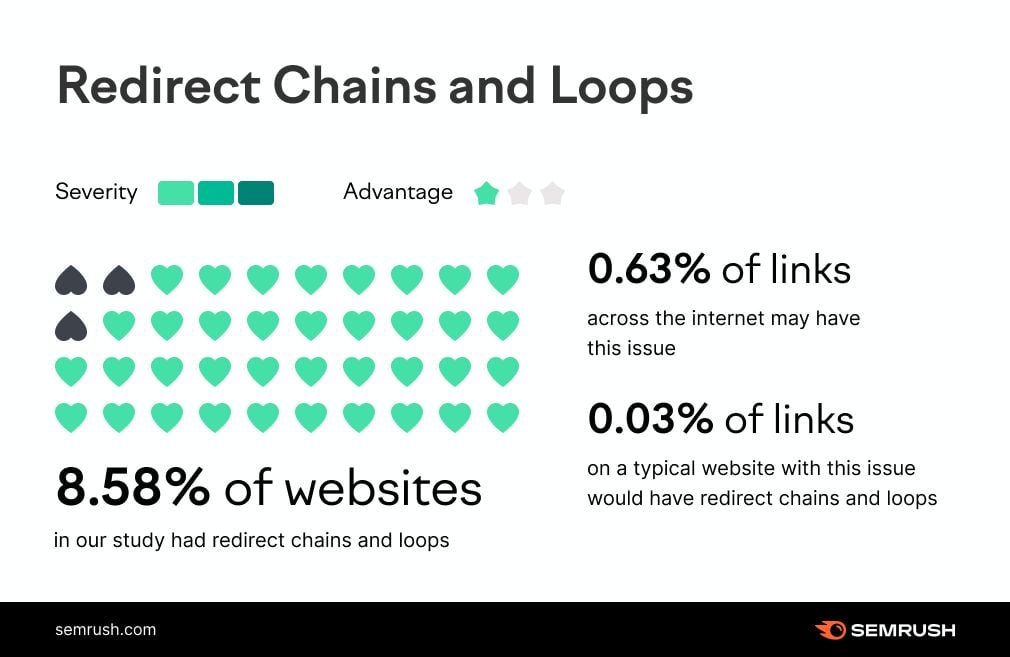Imagine this: you’re eagerly browsing a website, searching for valuable information or engaging articles. Suddenly, you encounter a frustrating loop of redirects, endlessly bouncing back and forth between pages. Such redirect chains can be a major annoyance, hindering your user experience and ultimately harming your website’s performance.

Image: neilpatel.com
The Cause of Redirect Chains
Redirect chains occur when a series of redirects is implemented from one URL to another, often without a clear endpoint. This can happen due to various reasons such as website restructuring, URL changes, or improper redirection setups. When users try to access a specific page, they’re instead sent on a wild goose chase through multiple redirects, which can result in slow loading times and confusion.
The Impact of Redirect Chains
The consequences of redirect chains extend beyond user frustration. They can significantly impact website performance and overall effectiveness. Search engines often penalize websites with excessive redirects, as they negatively affect page rankings and search engine visibility. Additionally, redirect chains can disrupt analytics tracking, making it difficult to analyze website traffic and identify areas for improvement.
Understanding Redirect Types
To effectively fix redirect chains, it’s crucial to first understand the different types of redirects:
- 301 (Permanent): Indicates that the page has permanently moved to a new URL.
- 302 (Temporary): Suggests a temporary change of address and that the user should be able to access the original URL in the future.
- 307 (Temporary Redirect): Similar to 302, but specifically used for HTTP POST requests.
- 308 (Permanent Redirect): Essentially the same as 301, but introduced later in the HTTP standard.

Image: neilpatel.com
Fixing Redirect Chains
Now that you have a better understanding of redirect types, let’s delve into the steps to resolve redirect chains:
- Identify Redirect Chains: Use tools like Screaming Frog or Ahrefs Site Audit to scan your website and locate any redirect chains.
- Analyze Redirect Purpose: Determine whether the redirects are necessary or if they can be removed. In many cases, it’s best to redirect old URLs to their current counterparts or directly to the relevant page, avoiding unnecessary redirects.
- Implement Proper Redirects: Use the appropriate redirect type based on the situation. Generally, 301 redirects are recommended for permanent changes, while 302 or 307 redirects are suitable for temporary redirects.
- Monitor and Test: After implementing the redirects, use the same tools to verify that the redirect chains have been resolved. Make sure to test different scenarios and URLs to ensure all redirects are functioning as intended.
Expert Tips:
- Avoid excessive redirects, as they can slow down website performance and harm SEO.
- Use canonical tags to specify the preferred version of a page, helping search engines identify the appropriate URL.
- Monitor redirect chains regularly to identify any broken or incorrect redirects.
FAQ on Redirect Chains
- Why should I fix redirect chains on my website?
Redirect chains can harm user experience, slow down website performance, and negatively impact search engine rankings.
- What is the best way to identify redirect chains?
Use tools like Screaming Frog or Ahrefs Site Audit to scan your website for redirect chains.
- How can I avoid creating redirect chains in the future?
Properly plan and implement URL changes, avoiding unnecessary redirects and using the appropriate redirect type.
How To Fix Redirect Chains
Conclusion
By understanding the causes, impact, and methods to fix redirect chains, you can ensure your website operates seamlessly and efficiently. Remember, a website free of redirect chains not only enhances user experience but also positively contributes to your overall SEO performance. Take action today to optimize your website and unlock its full potential. Are you ready to say goodbye to redirect chains and hello to a smoother, faster online presence?